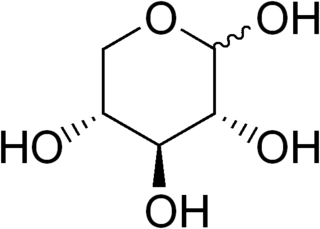
The EGF-like domain is an evolutionary conserved protein domain, which derives its name from the epidermal growth factor where it was first described. It comprises about 30 to 40 amino-acid residues and has been found in a large number of mostly animal proteins. Most occurrences of the EGF-like domain are found in the extracellular domain of membrane-bound proteins or in proteins known to be secreted. An exception to this is the prostaglandin-endoperoxide synthase. The EGF-like domain includes 6 cysteine residues which in the epidermal growth factor have been shown to form 3 disulfide bonds. The structures of 4-disulfide EGF-domains have been solved from the laminin and integrin proteins. The main structure of EGF-like domains is a two-stranded β-sheet followed by a loop to a short C-terminal, two-stranded β-sheet. These two β-sheets are usually denoted as the major (N-terminal) and minor (C-terminal) sheets. EGF-like domains frequently occur in numerous tandem copies in proteins: these repeats typically fold together to form a single, linear solenoid domain block as a functional unit.
In enzymology, a 4-galactosyl-N-acetylglucosaminide 3-alpha-L-fucosyltransferase is an enzyme that catalyzes the chemical reaction
In enzymology, an anthocyanin 3'-O-beta-glucosyltransferase is an enzyme that catalyzes the chemical reaction
In enzymology, a glycoprotein 2-beta-D-xylosyltransferase (EC 2.4.2.38) is an enzyme that catalyzes the chemical reaction
In enzymology, a lactosylceramide 4-alpha-galactosyltransferase is an enzyme that catalyzes the chemical reaction
In enzymology, a mannotetraose 2-alpha-N-acetylglucosaminyltransferase is an enzyme that catalyzes the chemical reaction
In enzymology, a N-acetyllactosaminide 3-alpha-galactosyltransferase is an enzyme that catalyzes the chemical reaction
In enzymology, a xylosylprotein 4-beta-galactosyltransferase is an enzyme that catalyzes the chemical reaction
In enzymology, a protein xylosyltransferase is an enzyme that catalyzes the chemical reaction in which a beta-D-xylosyl residue is transferred from UDP-D-xylose to the sidechain oxygen atom of a serine residue in a protein.
In enzymology, a xyloglucan 4-glucosyltransferase is an enzyme that catalyzes the chemical reaction in which a beta-D-glucosyl residue is transferred from UDP-glucose to another glucose residue in xyloglucan, linked by a beta-1,4-D-glucosyl-D-glucose bond.
In enzymology, a xyloglucan 6-xylosyltransferase is an enzyme that catalyzes the chemical reaction in which an alpha-D-xylosyl residue is transferred from UDP-D-xylose to a glucose residue in xyloglucan, being attached by an alpha-1,6-D-xylosyl-D-glucose bond.

Xylosyltransferase 1 is an enzyme that in humans is encoded by the XYLT1 gene.

Beta-1,4-galactosyltransferase 7 also known as galactosyltransferase I is an enzyme that in humans is encoded by the B4GALT7 gene. Galactosyltransferase I catalyzes the synthesis of the glycosaminoglycan-protein linkage in proteoglycans. Proteoglycans in turn are structural components of the extracellular matrix that is found between cells in connective tissues.

Xylosyltransferase 2 is an enzyme that in humans is encoded by the XYLT2 gene.

Xylosyltransferase are transferase enzymes which act upon xylose and are classified under EC 2.4.2.
Alpha-1,3-mannosyl-glycoprotein 2-beta-N-acetylglucosaminyltransferase is an enzyme with systematic name UDP-N-acetyl-D-glucosamine:3-(alpha-D-mannosyl)-beta-D-mannosyl-glycoprotein 2-beta-N-acetyl-D-glucosaminyltransferase. This enzyme catalyses the following chemical reaction
Alpha-1,6-mannosyl-glycoprotein 2-beta-N-acetylglucosaminyltransferase is an enzyme with systematic name UDP-N-acetyl-D-glucosamine:6-(alpha-D-mannosyl)-beta-D-mannosyl-glycoprotein 2-beta-N-acetyl-D-glucosaminyltransferase. This enzyme catalyses the following chemical reaction
Glucuronosyl-N-acetylgalactosaminyl-proteoglycan 4-beta-N-acetylgalactosaminyltransferase is an enzyme with systematic name UDP-N-acetyl-D-galactosamine:beta-D-glucuronosyl-(1->3)-N-acetyl-beta-D-galactosaminyl-proteoglycan 4-beta-N-acetylgalactosaminyltransferase. This enzyme catalyses the following chemical reaction
Rhamnopyranosyl-N-acetylglucosaminyl-diphospho-decaprenol beta-1,3/1,4-galactofuranosyltransferase is an enzyme with systematic name UDP-alpha-D-galactofuranose:alpha-L-rhamnopyranosyl-(1->3)-N-acetyl-alpha-D-glucosaminyl-diphospho-trans,octacis-decaprenol 3-beta/4-beta-galactofuranosyltransferase. This enzyme catalyses the following chemical reaction
Xylogalacturonan beta-1,3-xylosyltransferase is an enzyme with systematic name UDP-D-xylose:xylogalacturonan 3-beta-D-xylosyltransferase. This enzyme catalyses the following chemical reaction





